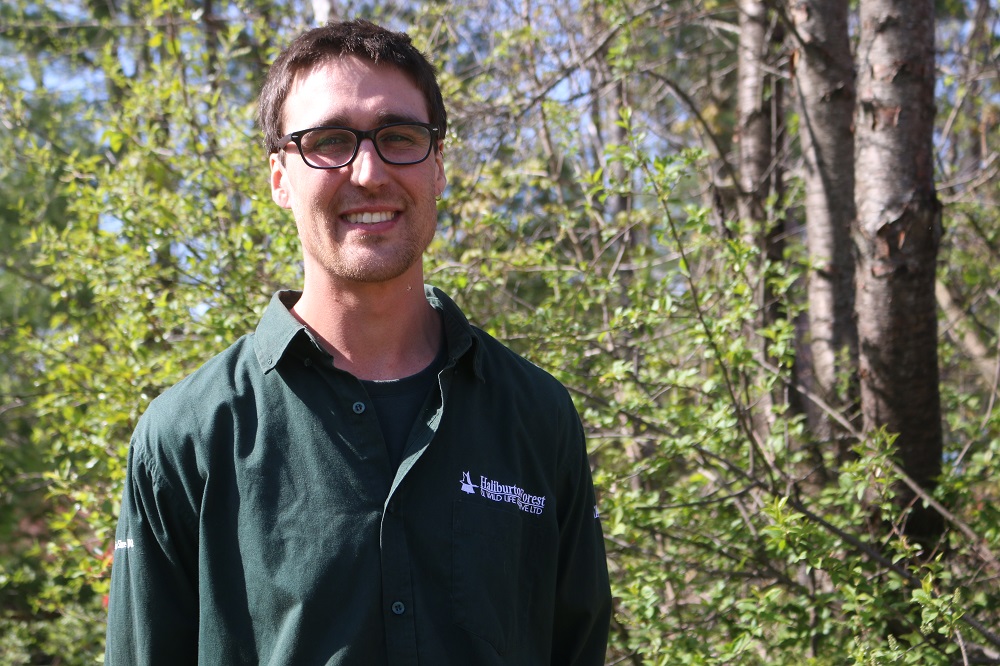Haliburton Forest and Wild Life Reserve held its first Research Day in more than four years May 13, inviting students and specialists from across Canada to share information and analysis on a range of forestry-related issues.
On the agenda this year were presentations on the impacts of beech bark disease, silviculture efforts at Haliburton Forest, the benefits of biochar technology, and a look at how declining moth populations is threatening birds and other wildlife in Ontario.
Organizer Adam Gorgolewski said there was a lot of good information, with around 40 people attending.
“Each year we try and cover a bit of everything that’s going on in Haliburton Forest. There are usually 20-plus research projects happening at any one time. Because we haven’t held an event for four years, I was able to narrow in on a few important topics that, literally, could change and help shape the way we operate in the future,” he said.
The morning presentations focused on forest management and silviculture. Gorgolewski spoke about how Haliburton Forest is changing the way it identifies trees for harvesting. For years, the business has followed the standard practice of individually studying and marking trees, making sure they were healthy enough to be harvested, which Gorgolewski said is “one of the most labourintensive parts of the way we manage our forest.”
During the pandemic, Forest staff piloted a new system that uses canopies to determine the underlying health of a tree.
“Rather than walking around every tree and scanning for every single defect and then doing the math to figure out when it’s likely to die, you can just look at the canopy and if it has 20 per cent or more die-back (decline), it’s quite likely to die over the next 20 years, or at least decline in quality,” he said.
Haliburton Forest produces approximately 110,000 fbm (board foot) of lumber each day across its four sawmill operations.
A species on the decline
Gorgolewski said beech bark disease is the “biggest, most significant problem” Haliburton Forest is currently facing. First identified on-site in 2010, the disease is spread through fungus that lives inside insects that feed off a beech tree’s sap. Once a tree is infected, it’s a death sentence, Gorgolewski noted, saying he expects the species will be wiped out completely by 2033.
“Beech trees represent around 15 per cent of all trees in Haliburton Forest… so that’s a massive decrease in the number of trees we will have,” he said.
There is a silver lining, though – he said staff will plant a variety of tree species in place of the fallen beeches, which will create a more resilient forest eco-system. That’s important, he said, at a time that invasive species are running roughshod on various tree populations.
“Probably a more present and imminent problem than climate change… invasive species are one thing that could make or break our forestry operations,” he said. “We weren’t prepared for [beech bark disease] when it appeared – if we had something similar come in and hit all of our maple trees, which makes up around 50 per cent of our tree population, then you’re looking at the majority of our trees being wiped out.”
An immediate concern is the increased presence of hemlock woolly adelgid – an aphid-like insect that attacks and kills hemlock trees – in the GTA.
“Our whole eco log business is based off lumber that comes from hemlock trees, so if that gets here, it’s going to have huge implications on how we operate,” Gorgolewski said.
The future
Biochar is a big part of Haliburton Forest’s future operations, Gorgolewski said. The company invested $10 million expanding its work in the field in 2022.
“There are hundreds of different uses of biochar. Most of the research we’ve done has focused on soil amendment and rejuvenation, but the possibilities are endless,” he said.
In her presentation, Lutchmee Sujeeun, a PhD student from the University of Toronto, indicated biochar has proven to positively affect the growth of certain tree species, particularly sugar maple and hemlock.
Biochar is a carbon-rich, charcoal-like substance produced by burning forest material in a zero-oxygen environment to create oil and gas by-products that can be used as fuel.
In a release last year touting the expansion, Haliburton Forest managing director Malcolm Cockwell said biochar produced on-site can be used to displace various fossil fuel products, resulting in a net reduction of 4,200 tonnes of CO2 equivalent emissions per year.
“We’re just getting started with biochar, and we hope to have another exciting announcement later this year,” Gorgolewski said.





